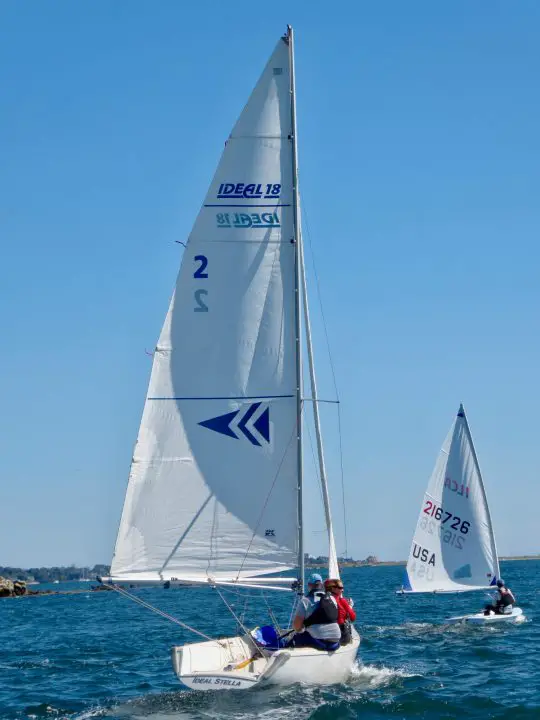One of the first sailing fundamentals you learn with you’re new to the world of sailing is the idea of sailing a boat into the wind. Sailboats can sail in the direction of the wind, but they do so by making a zig zag course made up of a series of maneuvers called tacks.

Table of Contents
- Why Does a Sailboat Tack?
- What Is a Tack of a Sail?
- What Are the Points of Sail Depending on the Wind Direction?
- How Does a Sailboat Sail Into the Wind?
- How to Tack a Sailboat – Step by Step
- How to Tack in Sailing Kept Simple
- FAQs (Frequently Asked Questions)
Why Does a Sailboat Tack?
Tack is a confusing word because it’s used in various ways on a sailboat. Depending on its usage, it can be either a noun or a verb.
First, as a noun, a tack is a maneuver that a sailboat makes when it turns in the direction of the wind blows. For example, a boat may be sailing on a port tack, with the wind coming from the left side of the boat. After the boat tacks—which in this case would be a turn to the left—the boat will be on a starboard tack, with the wind coming from the right-hand side.
As a verb, a skipper might yell, “Ready to tack!” to their crew to let them know that the boat is about to tack. An alternative command is “Ready about!”
Since a sailboat cannot sail directly into the wind, a boat makes a zig-zag course over the water to go in that direction. The zig-zag course is made up of a series of tacks.
What Is a Tack of a Sail?
The word “tack” has a second, entirely different definition on a sailboat, too. When discussing the parts of a sail, the tack is the lower rear corner of a triangular sail. So, the tack of a mainsail is the end attached at the back of the boom. The tack of a foresail, like a jib, is the one that you attach the jib sheets to.
The other two corners of sail are the head (at the top) and the clew (at the forward edge). The edges of sail are called the leech, luff, and foot. So more specifically, the tack is the corner where the leech and the foot meet.

What Are the Points of Sail Depending on the Wind Direction?
Sailboats can sail in nearly any direction except directly into the wind. Each direction has a different name and is known as a point of sail.
Sailors measure their angle to the wind based on the apparent wind angle (AWA). The AWA is simply the number of degrees from the bow that the wind is located. If a boat is headed dead into the wind, the AWA is 0 degrees. If the boat is headed dead downwind, the AWA is 180 degrees. Neither of these directions is optimal, so normal sailing occurs between 45 and 160 degrees AWA.
- Close Hauled — A boat that is as close to sailing upwind as it can is said to be “close-hauled.” In this scenario, the sails are tightly sheeted, and monohulls will be healed over. The AWA that a boat can sail depends on its design. Most boats cannot sail closer than 45 degrees to the wind. Colloquially sailors call sailing close-hauled “beating.”
- Close Reaching — A bit “farther off the wind,” and the boat will be close reaching. This is usually between 60 and 90 degrees AWA.
- Reaching — A boat is reaching when it is precisely 90 degrees AWA. This is actually the fastest point of sail for most boats.
- Broad Reaching — If a boat is reaching, but the wind is behind the beam, it is on a broad reach. This occurs between 90 and 120 degrees AWA.
- Running — When a boat is on a run, it is sailing downwind. In this situation, the sails act less like airplane wings generating lift and more like leaves blowing over the water.
- Wing-on-Wing — Wing-on-wing is a sailing maneuver, not a point of sail. But it occurs when a boat is more or less sailing dead downwind (180 degrees AWA). When a boat is wing-on-wing, one sail is on a starboard tack, and the other is on a port tack.
How Does a Sailboat Sail Into the Wind?
Contrary to what many people think, modern sailboats can sail in the direction of the wind. In fact, they can sail in nearly every direction relative to the wind except one. But they cannot sail directly into the wind. So if the wind blowing on the water today is out of the direction of your desired course, you’ll have to tack back and forth to get there.
For the sail to work, it needs to have air pushing on one side of it. If the boat is pointed directly into the wind, the sails will flap like flags on a pole. When this happens, the boat is said to be “in irons” and will eventually come to a stop.
How close to the wind a boat can sail depends on its design. Racing sailboats can do the best and generally sail within 30 degrees of the wind. However, cruising boats usually fall somewhere in the 45 to 60-degree range due to their wider beams and shallower keels.

What’s the Difference Between a Port or Starboard Tack?
The boat’s direction is always described in terms of the wind for a sailor. As such, one of the most fundamental terms in sailing is which tack a sailboat might be on. A port tack describes a boat with the wind coming over the port railing, so the sails are on the boat’s starboard side. Conversely, a boat on a starboard tack has the wind over that rail and the sails on the port side.
Describing which tack a boat is on is vital in racing and right of way rules. Rule 12 of the COLREGs, the internationally agreed-upon rules that govern shipping, says that when two sailing vessels meet, the vessel on the starboard tack has the right of way.
What’s the Difference Between a Tack and a Jibe (Gybe)?
If a tack has an opposite maneuver, it is likely a jibe, which is sometimes spelled “gybe.”
A jibe occurs when sailing downwind. For example, if a boat is running on a port tack and wants to switch to the opposite tack, they could go the long way around and tack through the wind, or they could sail through dead downwind. Passing dead downwind so that the sails switch is called a jibe.
Jibes are more dangerous maneuvers that tacks for a few reasons. A planned jibe that is well executed is perfectly safe, but the force of the boom passing over the boat can be significant. All crew should know that the jibe is occurring and duck down to avoid getting smacked by the boom.
An accidental jibe, which isn’t planned, can be catastrophic. The force of the boom crashing over the boat can be immense if the winds are strong. It can easily tear the sail, and brake lines or damage the boom or gooseneck fittings.
You should always take jibes slowly and carefully. The stronger the winds, the more careful you should be. When tacking, the crew’s attention is focused on the jib sheets, but in a jibe, the crew must pay close attention to the mainsail and boom. The jib will usually be blanketed by the wind and easy to control when sailing so deeply downwind, so the jib sheet will be easy to manage.
Anytime a jibe is imminent, be it purposeful or accidentally, the skipper shouts, “Jibe ho!” This is to let everyone know to be ready for the maneuver—or at least to get out of the way of the boom. In light wind, it is usually a nonevent, but care should be taken regardless.

How to Tack a Sailboat – Step by Step
How to tack a boat depends on the boat and how it’s set up. First, the boat is sailed close-hauled on the standard modern sloop with both sails sheeted in tight. With the mainsail brought in, it will be self-tending on its boom.
So besides turning the wheel, the crew needs to only worry about the jib. The crew will watch the jib as the skipper turns the boat and brings the helm about. When the sail begins to luff or flap, the crew will release the working sheet from its winch and start to bring in the lazy jib sheet on the other side of the boat.
The slacker you can take out of the line, the tighter the tack. Once the slack is out and the line secured on the drum, you can bring the sail in with the help of the winch handle.
The boat speed at which the crew works to switch the sheet depends greatly on the sort of sailing you’re doing. If it’s a solo skipping working alone with only the help of the sailboat autopilot, the emphasis is on making the tacking maneuver easy and safe. This means taking it slow and not rushing anything.
On the other hand, if the crew is prepping for a race, boat speed is of the essence. So they’ll want to pull off the tacking maneuver perfectly in sync. A sloppy tack means that the boat will slow down unnecessarily, and recovering from it may mean losing a little ground by sailing on a reach while the boat builds up boat speed again.
A good skipper will work out how to tack with their crew in advance. Tacking involves good communication and teamwork on a boat with more than one person. Cruising boats may care little if their tack is a little sloppy, but on a racing boat, a clean tack means no wasted time and competitive advantage.
How to Tack in Sailing Kept Simple
How to tack sailing boats might sound complicated, but it isn’t. It’s one of the simplest maneuvers to do in the sailing world, and it’s safe to do it in most conditions. Basic sailboat training begins with tacks because it requires understanding how a boat sails into the wind and how to handle it in different situations.
FAQs (Frequently Asked Questions)
What is a tack on a sailboat?
The word “tack” has a few meanings on a sailboat. The most common definition involves how a sailboat sails into the wind. A sailboat cannot steer directly into the wind and instead must follow a zig-zag course over the ground to make progress in that direction. To tack the sailboat is the action of turning its bow through the wind. This maneuver also called “a tack” (noun), is used to sail into the direction of the wind. Also, a sailboat can be on a port tack or starboard tack, depending on which side of the sails the wind is coming from. Finally, the tack of a sail is the bottom rear corner of a triangular sail.
What is the difference between a tack and a jibe?
Both a tack and jibe (sometimes spelled “gybe”) are used to describe maneuvers in which the boat is steered onto a new heading relative to the wind. In a tack, the boat is steered through the wind so that the wind is blowing from the opposite side of the boat. A jibe is done downwind but accomplishes the same thing. The boat is steered through a 180-degree apparent wind angle (AWA) during a jibe. The sails will switch in much the same way they do during a tack, but it is a very different maneuver.
What does tack mean for a ship?
A tack is a maneuver on a sailing ship where the ship’s bow is steered through the wind. After a ship tacks, the wind will be coming over the opposite rail. A ship’s sails will not work when pointed directly into the wind, so a ship must complete a series of tacks and make a zig-zag course over the ground to sail windward.
